TV Basics Online - Television Bureau of Advertising
TV Basics Online - Television Bureau of Advertising
TV Basics Online - Television Bureau of Advertising
Create successful ePaper yourself
Turn your PDF publications into a flip-book with our unique Google optimized e-Paper software.
<strong>TV</strong> <strong>Basics</strong><br />
Political <strong>Advertising</strong> &<br />
Government Regulation<br />
Congress, the Federal Communications Commission and the Federal<br />
Election Commission regulate broadcast political advertising <strong>of</strong> candidates<br />
and issues. Regulation focuses on two principal areas:<br />
Access: Only federal candidates have access rights. Stations must honor<br />
a federal candidate demand to purchase time.<br />
Rates: Federal, state and local candidates receive a station's best rate<br />
for its most favored advertiser during pre-election periods (the “lowest<br />
unit charge”). Issue advertisers are not entitled to the lowest unit charge.<br />
From these flow additional basic elements <strong>of</strong> broadcast political advertising:<br />
Equality: Any candidate may demand the same terms <strong>of</strong> a time buy that<br />
an opponent has purchased within the preceding seven days (the famed<br />
“equal opportunities” clause). Issue advertisers are not entitled to equal<br />
opportunities.<br />
Placement: <strong>Television</strong> news is a sacrosanct safe harbor from access<br />
demands. News adjacencies must be made available, however.<br />
Appearance: The right to the lowest unit charge is personal to a candidate,<br />
and therefore the candidate must personally appear in an ad to<br />
receive the lowest unit charge. Otherwise, comparable commercial rates<br />
apply.<br />
Pre-Election: The lowest unit charge must be made available within 45<br />
days <strong>of</strong> a primary and 60 days <strong>of</strong> a general election. At other times, comparable<br />
commercial rates apply.<br />
Sponsor ID: A political ad must contain a “disclaimer” that meets separate<br />
FCC and FEC requirements.<br />
Full service: Stations may charge usual and customary fees for services<br />
not related to the sale <strong>of</strong> time (e.g., production, talent, and distribution<br />
charges).<br />
Cash: Stations may require cash up-front for political advertising, including<br />
issue advertising, if station policy requires cash up-front for new commercial<br />
advertisers.<br />
Paperwork: Stations must document and make publicly available all<br />
requests and contracts for political advertising by anyone who wants to<br />
buy time for or against any candidate or on an issue <strong>of</strong> national importance.<br />
Separate FCC and FEC requirements apply.<br />
Few areas <strong>of</strong> federal regulation are more arcane and complex than<br />
broadcast political advertising. <strong>TV</strong>B’s desk reference, “Political <strong>Advertising</strong><br />
Handbook For The <strong>Television</strong> Sales Executive,” treats the subject in greater<br />
depth, and is available online, for <strong>TV</strong>B members only at www.tvb.org.<br />
Counsel should be consulted in a specific case.<br />
Source: Erwin G. Krasnow, John Wells King, <strong>of</strong> Garvey Schubert Barer<br />
28<br />
Consumer Media Usage<br />
Today, more and more media are competing for people’s time. <strong>Television</strong><br />
remains the clear winner, more than doubling the No. 2 medium,<br />
Broadcast & Satellite Radio.<br />
Hours Per Person Per Year Using Consumer Media – 2010<br />
Total <strong>TV</strong> 1<br />
Broadcast &<br />
Satellite Radio<br />
Pure-Play<br />
Internet 2<br />
Recorded<br />
Music<br />
Newspaper<br />
Out-<strong>of</strong>-Home<br />
Consumer<br />
Magazines<br />
Videogames<br />
Home Video3 Consumer<br />
Books<br />
& In-Flight<br />
Entertainment<br />
Pure-Play<br />
Mobile2 Box Office<br />
Local Consumer<br />
Directories<br />
Educational<br />
Books<br />
202<br />
138<br />
152<br />
134<br />
113<br />
99<br />
95<br />
55<br />
35<br />
11<br />
10<br />
8<br />
654<br />
1,730 1,730<br />
(1) Total <strong>TV</strong> includes Network-affiliated stations,<br />
Independent and Public stations, and Basic and<br />
Premium Cable, Satellite & RBOC Networks.<br />
(2) Internet and mobile use <strong>of</strong> traditional media,<br />
such as downloaded music, newspaper websites<br />
or info alerts, e-books, cable modems, online<br />
video <strong>of</strong> <strong>TV</strong> programs and Internet radio, was<br />
included in the traditional media segment, not<br />
in pure-play Internet or mobile content. Pureplay<br />
Internet and mobile services includes<br />
telecommunications access, such as DSL and<br />
dial-up, but not cable modems, pure-play content,<br />
such as eHarmony, GameSpy and Mobi<strong>TV</strong>,<br />
and mobile instant messaging and e-mail alerts.<br />
(3) Playback <strong>of</strong> prerecorded VHS cassettes and<br />
DVDs only.<br />
Source: Veronis Suhler Stevenson Twenty-Fifth<br />
Edition 2011-2015





